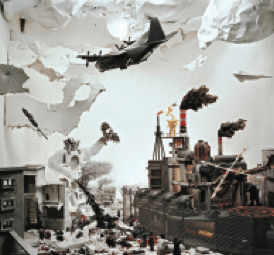Norton Maza
Bendana-Pinel, Paris
How difficult it is not to feel impressed by the work of Norton Maza-Lautaro (Chile, 1971 -). An oeuvre reflecting a personal life of exile and travels that allow him to trace a parallel between the northern and the southern hemisphere through a historical and political reflec- tion. The artist responds to the great consumerism of the north with banal objects and unusual recycled materials that he uses in his maquettes, parodies of an oeuvre charged with commitment, irony and sensibility with regard to the crude reality of two worlds at odds

It was to be expected that at his first solo show, entitled Le delire des sages (The Delirium of the Wise) and presented at Bendana- Pinel Gallery, Paris, Maza should also call the aesthetic role of photography into question and involve it in a process of irra- tional collective investigation. This series contains the first signs of a code that fluctuates indiscriminately between the aesthetic which is evident in his compositions and a new dimension of the social from the perspective of photography, while exalting a critical and affective conscience of the image. An image that turns out to be particularly clarifying when it makes reference to such burning issues as the devastations in Gaza, speculation in the American stock market, the flows of power and wealth, and so on. A reduced number of subjects that he reelaborates periodically, in an attempt to convey the difficulties and mis- eries that those countries undergo.
Maza builds objects, kinds of sculpture-objects with a fragile structure, such as the ones made by children. Toy-objects (heli- copters, airplanes, trucks, etc.) that the artist fabricates with hybrid materials found in the countries he visits, and which he arranges harmoniously later to photograph them. They are beings and situations that break free from the celluloid and reveal our everyday visual culture. Each photograph shows tempests individual or general static moments, moments of uncertainty and waiting. Prefabricated images, copies of copies of a created and creative reality, where the real world is trans- formed into images, and images are transformed into real beings. Through an ironic gaze, Maza presents his characters and objects, unique and universal at the same time, portrayed in static poses, but defining, in the overall composition, a dynamic, sequential and temporal scene. Thus he reconstructs those two worlds as a true theatrical performance, in which each element releases an energy of its own.
Likewise, his work breaks with the opposition between an elite art and a popular art via the parodic use of representation as critical formula to overcome rethorical conventionalisms. In his oeuvre, there are communicational codes generating particu- larities that identify us, and that reveal an aspiration to achieve a synthesis between human irrationality and political, social, religious and ethical impositions.
Through these varied photographic works that constitute the conflictive expressions of those “first-world nations”, the artist explores their individual strategies, creating a dialogue between contemporary art, mass culture and the representations of the past and the present; where each work contains the specific signs that show the crude contemporary realities. His work particular- ly clarifies some of the most conflictive issues. Which are some- waht diluted into false controversies and paradigms.





